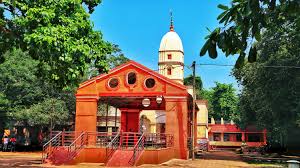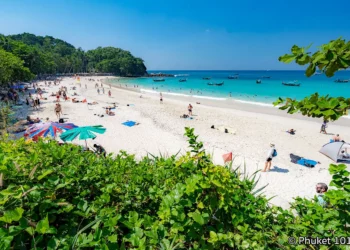The Kanak Durga Temple, in Chilkigarh, Jhargram, West Bengal, is a divine shrine dedicated to Goddess Durga. Set near the Dulung River in a thick forest, about 14 kilometers from Jhargram town, this temple is the main attraction of Jhargram district. This blog gives clear facts about the temple’s past, it’s architecture, its role in worship, and what you need to know to visit, based on what is known.
History of Kanak Durga Temple
The Kanak Durga Temple began over 500 years ago, built by King Gopinath of the Dhalbhum dynasty in the Jungle Mahal area. A story says the king dreamed of Goddess Mahamaya, who told him to build a temple and make her idol. That same night, a Brahmin named Ramchandra Sarangi and a sculptor named Jogendranath Kamiliya had the same dream. The king followed the goddess’s words, and the temple was made. The Sarangi family, Brahmins from Odisha, have been priests there ever since, passing the duty down through generations.
The temple’s name, Kanak Durga, comes from the two-foot idol of Goddess Durga, said to be gold or covered in gold, though some say it was first stone. Long ago, human sacrifices were part of the rituals, with blood flowing to the Dulung River, but the goddess stopped this, and now only goat sacrifices happen on Ashtami night during Durga Puja. Only royal family members join this night worship, and people believe the goddess cooks the offerings herself on Navami.Some say the first temple, possibly from 1348 AD, was hit by lightning, so a new temple was built next to it. During Maoist trouble in 2007–2008, the idol was stolen twice, so a new one was made from ashtadhatu, an alloy of eight metals, and cameras were added for safety. The temple is still a big part of Jhargram’s faith and culture.
Architecture of Kanak Durga Temple
The Kanak Durga Temple sits in a forest of sal, teak, and healing plants, with the Dulung River to its east. The old temple, now broken and worn, is near the new temple, where the current idol of Goddess Durga is kept. The design is simple, showing Odiya style, and the new temple was made to keep the holy place safe. The two-foot idol, gold or gold-plated, is in the main room, called the garbha griha. There is a ghat by the river for bathing during prayers and a place for sacrifices, tied to old rituals. The temple area has a children’s park, parking, and small shops with puja items and food. The forest around it has rare trees, birds, and monkeys, which might take food, so visitors must be careful. The old temple’s cracked walls are good for photos, and the new temple is clean with open space.
Rituals and Worship
The Kanak Durga Temple is a key spot for Durga worship in Jhargram, especially during Durga Puja in October, when Ashtami night prayers bring many people. The goddess, known lovingly as Mahamaya or Chandi, is seen as a source of strength, giving blessings for safety and good fortune. The Sarangi priests do Panchopachar puja in the tantric way, mixing tribal and traditional styles. The Shri Shri Durga Puja and an old kite festival from King Mangobinda’s time show the temple’s role in local life. Stories say the goddess stopped the temple from moving and made nearby Shiva shrines in one night, adding to its mystery. The forest and river make it a quiet place for prayer, perfect for those wanting peace away from towns.
Things to Do at Kanak Durga Temple
Visitors can do things that mix faith, history, and nature:
Join in Prayers: Take part in pujas, especially during Durga Puja, to see the Sarangi priests’ rituals.
See the Temple Area: Look at the old and new temples, the river ghat, and the sacrifice spot.
Walk in the Forest: Take a short path to see healing plants, rare trees, and birds at Kendua, good for birdwatching in winter.
Visit Nearby Places: See the Chilkigarh Raj Palace, 2 kilometers away, with its Italian-style design, or the Amlachati Medicinal Plant Garden, 14 kilometers from Jhargram.
Try Local Things: Buy puja items or food at shops, or use the children’s park, good for families.
Visiting Information for Kanak Durga Temple
How to Get There
The temple is in Chilkigarh, 14 kilometers from Jhargram town, with different ways to travel.
By Plane: The closest airport is Netaji Subhas Chandra Bose International Airport in Kolkata, 188 kilometers away. Taxis or buses from Kolkata to Jhargram take about 4 hours, then a 20-minute ride to Chilkigarh through Jamboni.
By Train: Jhargram Railway Station, on the Howrah-Tatanagar line, is 14 kilometers away. Trains like the Ispat Express take 2 hours 24 minutes from Howrah. From the station, take a taxi, toto (e-rickshaw), or car to the temple.
By Road: From Kolkata, take NH6 (Mumbai-Kolkata Highway), 178 kilometers to Jhargram, then 14 kilometers to Chilkigarh. The Jamboni road is pretty and good to drive. Taxis, totos, or cars work, and there is parking at the temple.
Temple Hours
The temple opens at 10:30 AM and closes around 7:00 PM. During Durga Puja, it may stay open longer. Don’t come too early, as it opens late. Ask temple workers for exact times during festivals.
Best Time to Go
The best time is November to February, when it’s cool, from 10°C to 25°C. Durga Puja in October is lively but busy. Summers (April–June) are hot, up to 35°C, so go early. Rainy months (July–September) make the forest green but the river may flood, so check ahead.
Rules for Visitors
Wear proper clothes: men need shirts, trousers, or dhotis with a cloth over the shoulder and women need sarees, half-sarees, or churidar with a dupatta. Shorts, sleeveless tops, and jeans are not good. Take off shoes, with a place to keep them. Watch for monkeys taking food. No smoking, alcohol, littering, or spitting is allowed. Taking pictures inside may need permission from priests. Respect the no-smoking, no-alcohol rule.











